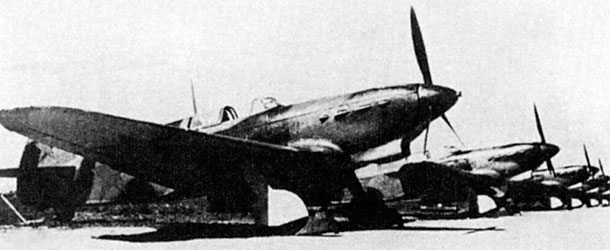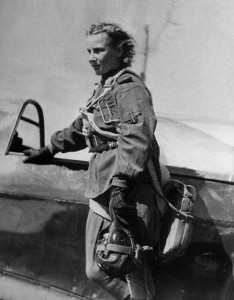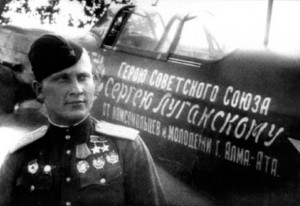Following the preview dedicated to the Curtiss P-40 Warhawk, it’s time to know something more about the Soviet fighter Yakovlev Yak-1, an agile and fast single-seat monoplane that came into service just in time to meet the German Invasion in 1941. Extremely maneuverable, fast and well armed, the Yak-1 was also easy to maintain and reliable. The primary user was the Soviet Air Force, but also France and Poland employed this fighter.
The Yak-1 was designed by Aleksandr Sergeievich Yakovlev in 1938, answering a requirement for a single engine lightweight front fighter for the UV-VS. The project was selected and Yakovlev received the Order of Lenin, 100,000 rubles, and an automobile. The prototype I-26 first flew in January 1940.
The fighter was designed to use cheap materials and integral armament, with nose-mounted cannon. It showed immediate promise and was rushed into production even before trials were complete. In June 1941 there were approximately 400 Yak-1s available. By March 1942, the Yak-1 was being produced in a lightened form to obtain an increased agility.
The Yak-1 had a structure of metal and wood. The cockpit gave the pilot excellent views, and its all-metal wings were replaceable in the field quite easily. The M-105PF engine was installed to reduce weight to help increasing performance.
The aircraft later evolved into better designs, especially the Yak-3, which had a much improved field of vision for the pilot and was one of the most agile fighters in WW2.
The two Yakovlev Yak-1 featured in the Wings of Glory WW2 airplane packs are the ones piloted by Lydia Litvjak, the “White Rose of Stalingrad”, one of the world's only two female fighter aces, and the Capitan Sergej Danilovich Lugansky, a master of ‘Taran’ attack.
The woman ace Lydia Vladimirovna Litvjak (nickname Lylia) was born in Moscow on August 18, 1921 and joined the Soviet Air Force on January 1942, at the all-woman 586 Fighter Aviation Regiment (IAP). On August, her merits led her to the all-male squadron 286 IAD (Fighter Aviation Division), and following to the 437 IAP, a men's regiment fighting over Stalingrad.
In the 437th Fighter Regiment, Litvjak scored her very first two kills on 13 September, three days after her arrival and on her third mission to cover Stalingrad, becoming the very first woman fighter pilot to shoot down an enemy aircraft.
On January 1943, she was transferred to the 296 IAP, and in that unit she flew the "Yellow 44" Yak-1, scoring six victories before the plane was hit by escorting Me-109s on March 1943. Litvjak managed to make her home base and crash-landed, and remained in the hospital until May 1943. When she returned, 296 IAP had been renamed 73 GvIAP (Guards Fighter Aviation Regiment) and was equipped with a fleet of improved Yak-1b aircraft. Lilya's aircraft was "White 23", and she was repeatedly successful on escort missions and scored four more victories until August 1, 1943.
That day, while escorting a unit of Il-2 "Shturmovik"s returning from an attack, her Yak-1b was shot down by some fighters Bf 109. Her body and aircraft were never found during the war, and there were a controversial about her death. Soviet authorities suspected that she might have been captured. On 1979, remains of an unidentified woman pilot were found buried in Dmitrievka, Shakhterski district, and a commission of specialists examined it and concluded the remains were those of Litvjak. On May 1990, the title "Hero of the Soviet Union" was conferred her by the president Mikhail Gorbachov.
When she presumably died, Litvyak was 22 years old. There are some controversies also about Litvyak's victory score, with conflicting claims in different publications; none are official records. Most often, 11 individual kills and 3 team kills are quoted, but also 12 individual and 2 team, 8 individual and 4 team, or other combinations. Litvyak was called the "White Lily of Stalingrad" in Russia and the "White Rose of Stalingrad" in Europe and North America, after reports of her exploits were first published in English.
Among the airplanes Lylia shot down there was the Bf.109 G-2 di Erwin Maier, from the Jagdgeschwader 53, who refused to believe that he had been shot down by a woman until she described him each movement of the duel.
Kapitan Sergej Danilovich Luganskij, born in 1918 in Alma-Ata, Kazakhstan, was one of the best Soviet pilots, been twice awarded as Hero of the Soviet Union. He achieved 37 kills during the Great Patriotic War (1941-1945) - two of these kills were by "Taran" attacks (air-to-air ramming).
Luganskij entered in the Orenburg military pilot school at 18 years old. His first combat experience was in the 25 IAP, during the Soviet-Finnish War (1939-40), when he conducted 59 sorties and shot down one enemy aircraft. When the war with Germany started, Luganskij was deployed from October 1941 on the front.
During the war, Luganskij carried out 390 sorties, with 37 personal wins and other 6 in group fights. During the war he flew a fighter Yak-1b with the fuselage with a "white 58" (November 1943). He became commander of 270 IAP, and distinguished himself at Stalingrad, the Battle of Kursk and Kharkov, and was awarded with the Gold Star of Hero of the Soviet Union in September 1943 and in July 1944. In addition to two gold stars, he was highly awarded, receiving also the Order of Lenin , two Order of the Red Banner, Order of Alexander Nevsky , two Order of the Red Star , the Medal "For defense of Stalingrad" and the Medal "For the conquest of Königsberg”.
The two ramming attacks that gave him the “Master of Taran” title were performed while covering Soviet Army’s river crossings. The first one was on September 14th, 1942. Having run out of ammunition, Luganski decided to perform a "Taran" attack against an enemy formation, which was approaching River Volga in the air above the General Rodimtsev’s division. He knocked down a Romanian He.112 with a damaged wing. Next time, the "Taran" attack was accomplished while flying over the Dnepr River - this time the victim was a He 111.Luganski was lucky in both case, coming out of the ramming attacks alive - unlike most Soviet pilots who performed this type of attack.
After the war he held command positions in the VVS ROC, and in 1957 he was promoted to the rank of Major-General. Luganskij died in 1977.
The Luganskij airplane featured in the Wings of Glory WW2 operated in the Ukrainian front by the end of 1943, when the ace had scored 32 wins. The aircraft has in the left side the writing “Aircraft donated by Alma-Ata’s Socialist Youth”.
Information sources: AircraftAces.com, WWII Vehicles.com, WWII Ace Stories, Internet Modeler, Wikipedia.












Follow Us on